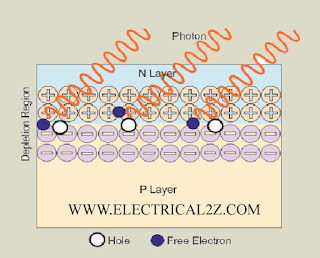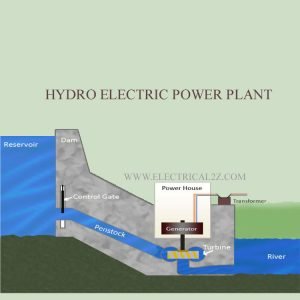Solar Power Plant | Solar Energy | When sunlight strikes on photo-voltaic solar cells, solar energy is produced. This is also known as photo-voltaic solar or PV solar.
Working Principles of Solar Power Plant
In the solar energy system, generating the electricity is depends upon the photo-voltaic effect. In the photo-voltaic effect, semiconductor p and n junction produce an electric potential when it is exposed to sunlight. For that purpose, we make n-type semiconductor layer of the junction very thin. It is less than 1 μm thick.
The top layer is n layer. We generally refer to it as an emitter of the cell. The bottom layer is p-type semiconductor layer and it is much thicker than the top n layer. It may be more than 100 μm thick. We call this bottom layer as the base of the cell.
The depletion region is created at the junction of these two layers due to immobile ions. When sunlight strikes on the cell, it easily reaches up to p-n junction. The p n junction absorbs the photons of sunlight ray and consequently, produces electrons holes pairs in the junction.
Actually, the energy associated with photon excites the valence electrons of the semiconductor atoms and hence the electrons jump to the conduction band from valence band leaving a hole behind each.
The free electrons, find themselves in the depletion region will easily pass to the top n layer because of attraction force positive ions in the depletion region.
In the same way, the holes find themselves in the depletion region will easily pass to the bottom p-layer because of the attraction force of negative ions in the depletion region. This phenomenon creates a charge difference between the layers and resulting in a tiny potential difference between them.
The unit of such a combination of n-type and p-type semiconductor materials for producing an electric potential difference in sunlight is called solar cell. Silicon is normally used as the semiconductor material for producing such a solar cell.
 |
| What is Solar Energy |
Grid-Connected PV System – Solar Energy
The system always has a connection to the public electricity grid via a suitable inverter because a photo-voltaic panel or array only delivers DC power. The additional components that make up a grid-connected PV system compared to a standalone PV system. They are
- The Inverter
- Electricity meter
- AC breaker panel and fuses
- Safety switches and cabling
- The electricity grid
Without batteries in the grid-connected system is the cheapest solar power plant setup available, and by not having to charge and maintain batteries they are also more efficient. A grid-connected solar power plant system is not an independent power source, unlike a stand-alone system. Should the mains supply from the electrical grid be interrupted, the lights may go out, even if the sun is shining. One way to overcome this is to have some form of short term energy storage built into the design.
Inverter
It is the most important part of any grid-connected system in solar energy. The inverter extracts as much DC electricity as possible from the PV array and converts it into clean mains AC electricity at the right voltage and frequency for feeding into the grid or for supplying domestic loads.
Electricity Meter
The meter is used to record the flow of electricity to and from the grid. The electricity meter also called a Kilowatt hour (kWh) meter. Twin Kilowatt hour meters can be used, one to indicate the electrical energy being consumed and the other to record the solar electricity being sent to the grid. A single bidirectional electricity meter can also be used to indicate the net amount of electricity taken from the grid. A grid-connected PV system will slow down or halt the aluminum disc in the kilowatt-hour meter and may cause it to spin backward. This is generally referred to as net metering.
AC Breaker Panel and Fuses
The AC breaker panel or fuse box is the normal type of fuse box provided with a domestic electricity supply and installation with the exception of additional breakers for inverter and/or filter connections.
Safety Switches and Cabling
The safety switches provide safety when the device in disconnect or reconnect period. A photo-voltaic array will always produce a voltage output in sunlight so it must be possible to disconnect it from the inverter for maintenance or testing. Isolator switches rated for the maximum DC voltage and current of the array and inverter safety switches should be provided separately with easy access to disconnect the system.
Other safety features demanded by the electrical company may include earthing and fuses. The
cables used to connect the various components must also be properly rated.
The Electricity Grid
The electricity grid itself to connect too finally, because without the grid it is not a Grid Connected PV System.
Standalone Solar Photo-voltaic System – Solar Power Plant
In the standalone solar power plant system, only solar energy used as the main source of energy. There are many locations in this world where no source of electricity is available. At these locations, a standalone solar power plant system can be the ideal source of electricity. The main advantage of this system is that it does not depend on a grid or any other source of electricity.
As it does not have any connection with grid or another electric supply line, it is also known as an off-grid photo-voltaic system. The sun is the only source of energy in this system it should have some means to make it active even in night times. A storage battery system does the job. So, a storage battery system is an essential component of this system. But, often this battery system can be omitted from the system if the system is dedicated for the load which to be operated in day times only.
Popular examples of the standalone solar energy system are solar lanterns, solar home lighting systems and solar water pumping systems. Types of Standalone Solar Systems Depending upon the use and design there are different types of standalone solar systems.
1. Standalone Solar (PV) system (DC load only)
2. Standalone Solar (PV) system (DC load and Electronics control circuitry)
3. Standalone Solar (PV) system (DC load, Electronics control circuitry and Battery)
4. Standalone Solar (PV) system (AC/DC load, Electronics control circuitry and Battery)
Hybrid Solar Photo-voltaic System
The power systems are the combination of two different power generation system, they are solar PV and another power generating energy source.
Hybrid Energy System – Solar Power Plant
Reasons behinds hybrid energy system installation is intermittent energy resources and energy resources unbalance. The solar photo-voltaic and wind hybrid system suits to conditions where sunlight and wind have seasonal shifts. As the wind does not blow throughout the day and the sun does not shine for the entire day, using a single source will not be a suitable choice.
A hybrid arrangement of combining the power harnessed from both the wind and the sun and stored in a battery can be a much more reliable and realistic power source. The load can still be powered using the stored energy in the batteries even when there is no sun or wind. Hybrid systems are usually built for the design of systems with the lowest possible cost and also with maximum reliability.
The high cost of solar photo-voltaic cells makes it less competent for larger capacity designs. This is where the wind turbine comes into the picture, the main feature being its cheap cost as compared to the PV cells. A battery system is needed to store solar and wind energy produced during the day time.
During night time, the presence of wind is an added advantage, which increases the reliability of the system. In the monsoon seasons, the effect of the sun is less at the site and thus it is apt to use a hybrid wind-solar system.
The hybrid solar PV system components are as follows,
- Photo-voltaic solar power
- Wind power
- Batteries
- The Inverter
- Micro-controller
Photo-voltaic Solar Power
Solar panels are used to convert solar energy into electrical energy. It can convert the energy directly or heat the water with the induced energy. Photo-voltaic cells are made up from semiconductor structures as in the computer technologies. Sun rays are absorbed with this material and electrons are emitted from the atoms. This release activates a current.
 |
| Photo-voltaic system – Solar Power Plant |
Photo-voltaic is known as the process between radiation absorbed and the electricity induced. Solar power is converted into an electric power by a common principle called the photoelectric effect. The solar cell array or panel consists of an appropriate number of solar cell modules connected in series or parallel based on the required current and voltage.
Wind Power
One of the renewable sources of energy is wind energy. Wind turbines are used to convert wind power into electric power. The generator inside the wind turbine converts mechanical power into electric power. The turbine systems are available ranging from 50 W to 3-4 MW.
The energy production by wind turbines depends on the wind velocity acting on the wind turbine. Wind power is able to feed both energy production and demand in rural areas. It is used to run a windmill which in turn drives a wind generator or wind turbine to produce electricity.
Batteries
To store the electricity that is generated from the wind or solar energy we use batteries in the system. Any required capacity can be obtained by serial or parallel connections of the batteries. The battery that provides the most advantageous operation in the solar energy and wind power systems are maintenance free dry type and uses the special electrolytes. The batteries provide perfect performance for long discharges.
Inverter
An inverter is used to converts DC supply into AC supply. Energy stored in the battery is drawn by electrical loads through the inverter, which converts DC power into AC power. The inverter has inbuilt protection for short circuit, overload, reverse polarity, and low battery voltage.
Micro-controller
The device compares the input of both the power system and gives the signal to the particular relay and charges the DC Battery. The DC voltage is converted into AC supply by an inverter circuit. In the secondary tapped
transformer, the MOSFET – IRF 540 is connected. By triggering of MOSFET alternatively, the current flow in the Primary winding is also an alternative in nature and we get the AC supply in the primary winding of the transformer.
Hope you understand this article about the What is Solar Energy – Solar Power Plant Working. In case of any doubt please comment below. Please follow our website for future updates. Thank you for visiting our website @ElectricianWorld.Net





